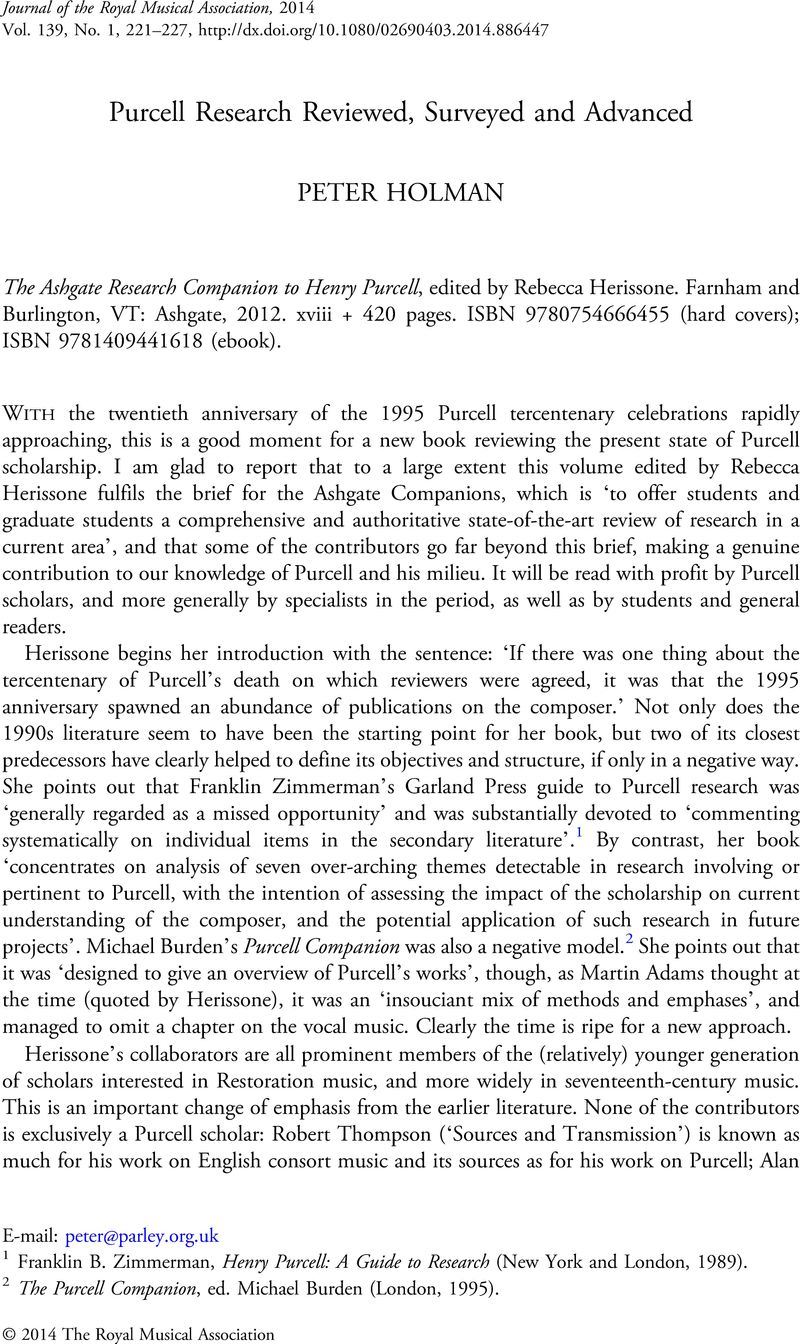No CrossRef data available.
Article contents
Purcell Research Reviewed, Surveyed and Advanced
Published online by Cambridge University Press: 01 January 2020
Abstract

- Type
- Review Articles
- Information
- Copyright
- Copyright © 2014 The Royal Musical Association
References
1 Franklin B. Zimmerman, Henry Purcell: A Guide to Research (New York and London, 1989).
2 The Purcell Companion, ed. Michael Burden (London, 1995).
3 Rebecca Herissone, Music Theory in Seventeenth-Century England (Oxford, 2000).
4 Peter Holman, Henry Purcell (Oxford, 1994), viii.
5 Robert Shay and Robert Thompson, Purcell Manuscripts: The Principal Musical Sources (Cambridge, 2000).
6 Ross Duffin, ‘New Light on Jacobean Taste and Practice in Music for Voices and Viols’, Le concert des voix et des instruments à la Renaissance, ed. Jean-Michel Vaccaro (Paris, 1995), 601–18.
7 Donald Krummel, English Music Printing, 1553–1700 (London, 1975).
9 Alan Howard, ‘Purcell and the Poetics of Artifice: Compositional Strategies in the Fantasias and Sonatas’ (Ph.D. dissertation, King's College London, 2006); idem, ‘Composition as an Act of Performance: Artifice and Expression in Purcell's Sacred Part-Song “Since God so tender a regard”’, Journal of the Royal Musical Association, 132 (2007), 32–59.
10 Martin Adams, Henry Purcell: The Origin and Development of his Musical Style (Cambridge, 1995).
11 Rebecca Herissone, ‘The Revision Process in William Turner's Anthem “O praise the Lord”’, Journal of the Royal Musical Association, 123 (1998), 1–38; eadem, ‘Richard Goodson the Elder's Ode “Janus did ever to thy sight”: Evidence of Compositional Procedures in the Early Eighteenth Century’, Music and Letters, 79 (1998), 167–91; eadem, ‘“Fowle Originalls” and “Fayre Writeing”: Reconsidering Purcell's Compositional Process’, Journal of Musicology, 23 (2006), 569–619.
12 Edited in Matthew Locke, Anthems and Motets, ed. Peter Le Huray, Musica Britannica, 38 (London, 1976), 36–8.
13 Thurston Dart, ‘Purcell and Bull’, Musical Times, 104 (1963), 30–1.
14 Records of English Court Music, ed. Andrew Ashbee, 9 vols. (Snodland and Aldershot, 1986–96).
15 The London Stage 1660–1800, part 1: 1660–1700, ed. William Van Lennep (Carbondale, IL, 1965); A Biographical Dictionary of Actors, Actresses, Musicians, Dancers, Managers, and Other Stage Personnel in London, 1660–1800, ed. Philip H. Highfill, Jr, et al., 16 vols. (Carbondale and Edwardsville, IL, 1973–93).
16 Bryan White, ‘Letter from Aleppo: Dating the Chelsea School Production of Dido and Aeneas’, Early Music, 37 (2009), 417–28 (pp. 419–20).
17 Henry Purcell, Complete Ayres for the Theatre, The Parley of Instruments, The Parley of Instruments Baroque Orchestra / Roy Goodman, Hyperion CDS443813 (1995).
18 Martin Adams, ‘Purcell's “Curiously Poor and Perfunctory Piece of Work”: Critical Reflections on Purcell via his Music for the Centenary of Trinity College, Dublin’, Music, Ireland and the Seventeenth Century, ed. Barra Boydell and Kerry Houston, Irish Musical Studies, 10 (Dublin, 2009), 181–202.
19 Holman, Henry Purcell, 80–1.
20 Peter Holman, ‘“Evenly, Softly and Sweetly Acchording to All”: The Organ Accompaniment of English Consort Music’, John Jenkins and his Time: Studies in English Consort Music, ed. Andrew Ashbee and Peter Holman (Oxford, 1996), 353–82 (pp. 368, 372).
21 Michael Tilmouth, ‘A Calendar of References to Music in Newspapers Published in London and the Provinces (1660–1719)’, RMA Research Chronicle, 1 (1960), 14.
22 John Higney, ‘Henry Purcell: A Reception/Dissemination Study, 1695–1771’ (Ph.D. dissertation, University of Western Ontario, 2008).




